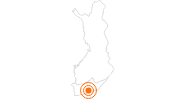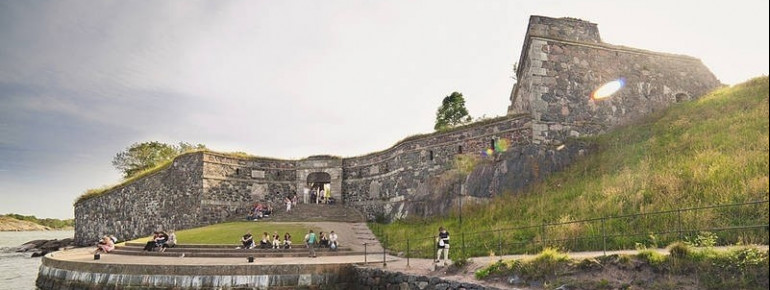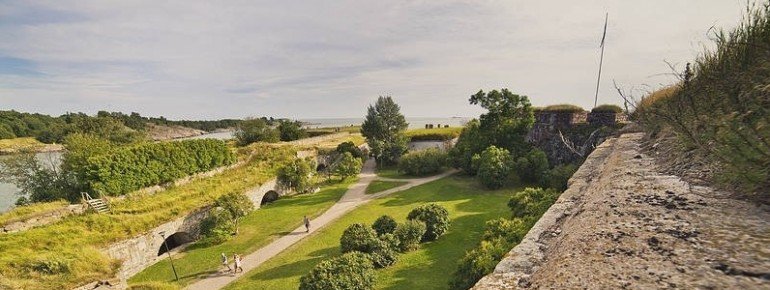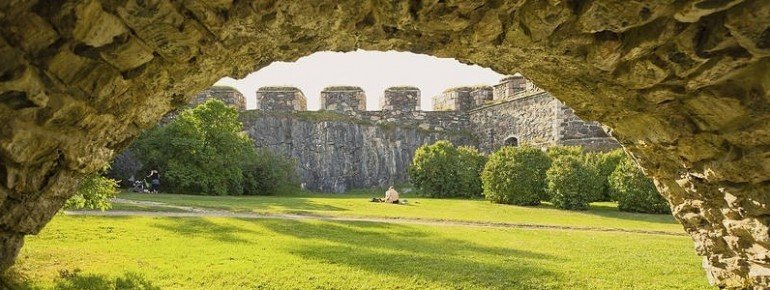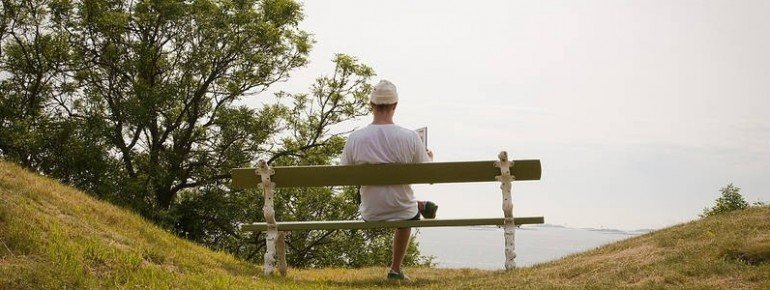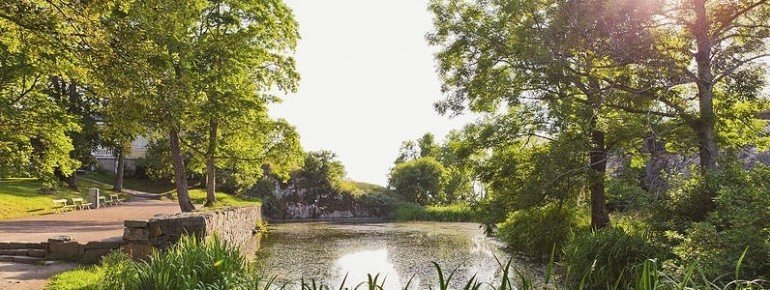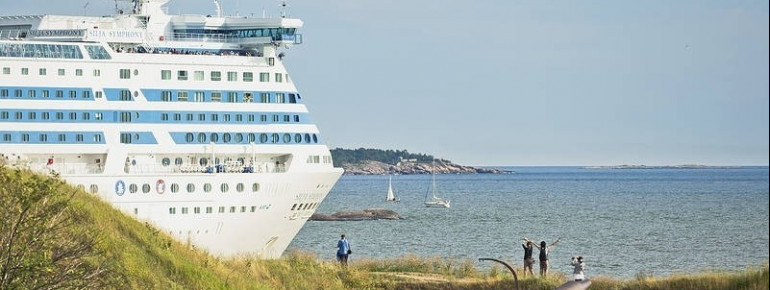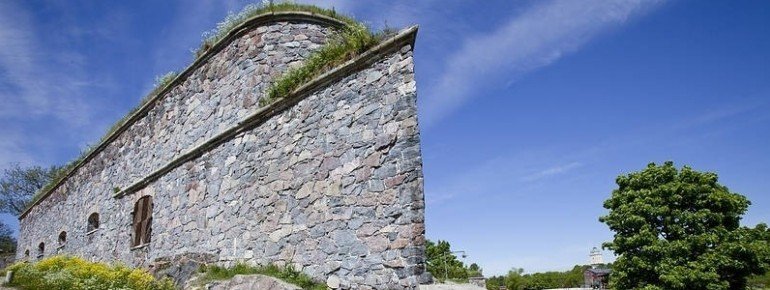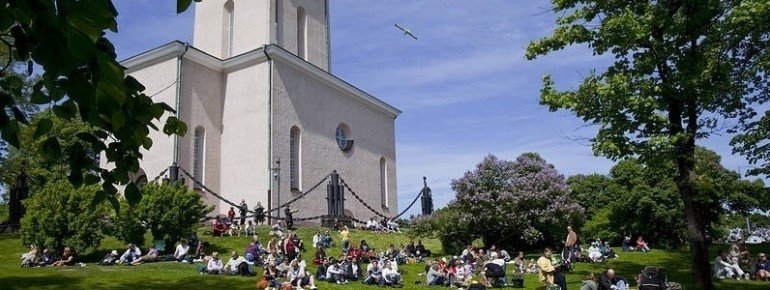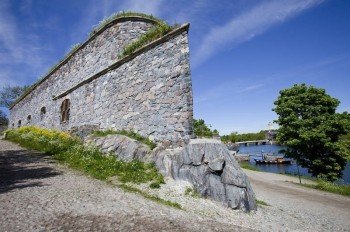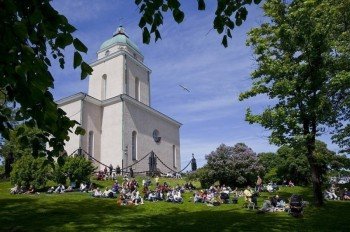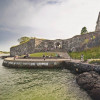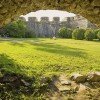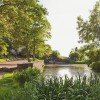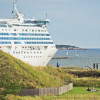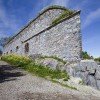Contents
Description
Suomenlinna is part of the UNESCO World Heritage and one of the most popular tourist attractions in all of Finland.
Even though the castle is already very impressive on the outside , there is much more to it than a pretty exterior. On the inside of the buildings and on the plazas you will find for example six museums. For the ultimate experience participate in one of the tours so you won't miss a thing.
The most important sights are found on the “Blue Path”. As the name indicates this is a blue marked path which leads you from the north of the fort past the Jetty Barracks all the way to the south of the fort ending at the Kings Gate. The total length of this path is about 1.5 kilometers (0.9 mi).
For wheelchairs or people with limited mobility there are alternative routes on the Blue Path to suit all the visitors' needs.
Sightseeing
The “Jetty Baracks” are the first thing the visitors will see when they reach the shore. The building made out of pink cobblestone functions as the entrance of the fort and is found at the coastline of the region. The barracks where built between 1868 and 1870 to accommodate 250 soldiers during time of peace. One part of the building was used as the main building where apart from the rooms of commissioned officers you would find prison cells.
Today this is an important building for visitors because it has been turned into the Tourist Information Center.
The King's Gate was built between 1753 and 1754 and is until today the passage to the fort. The gate is on the side of the building where King Adolf Frederick from Sweden went to visit the construction site in 1752. During the Crimean War the gate and the seaside wall were completely destroyed through a bombing. For the visit of the King and Queen of Sweden the destroyed parts of the building where renovated and rebuilt. For the 250th birthday of Suomenlinna the castle was again refurbished.
In the 1760s the construction for the castle courtyard “Great Courtyard” was finished. Here was the administrative center of the fortress. In the houses surrounding the courtyard there used to live the commanders and the main building of the soldiers would be found here as well. Really impressive about this courtyard is the design and the placement of the surrounding buildings. Through that creative choice the courtyard seems much bigger than it actually is. In the middle of the the square you will find the grave of Augustin Ehrensvärd, the constructor of the fort.
The Dry Dock is the oldest of its kind in Finland and is still in use today. Construction started in 1750 and until 1808 the dock was used as basis for the Swedish squadrons. In the 1760s people built ships for the Swedish navy at the dock. Starting in 1918 the dock was used as an submarine basis. After World War II the dock was again used for building ships - this time as reparation payment to Russia. Today the dock is used to repair old sailing boats. You can't get access onto the actual dock but from a look out point nearby you get a fantastic view onto the dock.
The Suomenlinna Church was built in 1854 as a Russian-Orthodox Garrison Church which is why it had the typical characteristic 'onion spires'. With the Independence of Finland the appearance of the church was changed. The towers were removed and the layout was changed from a round shape to a square form. The church is nowadays very popular for marriages, concerts and other formal events.
On the Zander Bastion in the southern part of Suomenlinna you will find the Finish flag posted every year from the 12th of May to the 29th of September ever since Finland attained independence. The bastion was one of the four bastions built between 1748 and 1750. From up there you have a beautiful view onto the entire fortress.
In the very early years of Finland’s independence Suomenlinna was used as a detention camp. During the civil war there were up to 10.000 prisoners within the walls of the fort. 20% of said prisoners died within the detention center. The Prisoners of War Memorial was opened on the 28th of September in 2004 at the Casino Park on Iso Mustassaari Island and reminds the people of these troubled times.
Advice: Some parts of the walls have no railings to hold on to. You should be extremely careful so you don't fall down. Plants and snow will make it hard for you to see the edges.
Museums
The Suomenlinna Museum is located in the center of the fortress and is open all year round. The exhibit shows the 260 year long history of the castle and its inhabitants with the help of digitized story books and archeological findings. You can also learn something about recent renovations. There is a short film about the fortress definitely worth the visit.The following museums are only open during summer.
The Ehrensvärd Museum is situated in the former house of the commander. You will find many objects representing the time when the fortress was strongly influenced by Sweden. The first proprietor of the building was the founder of the fort, Augustin Ehrensvärd.
A rather special experience is the tour through the old (but by now restored) submarine Vesikko. When you get a look inside ask yourself the following question: could you imagine working with 20 other people in this small space?
If you want to learn more about the fortress and its military history you should visit the Military Museum. The exhibition "From Autonomy to Atalanta" offers a fantastic overview of the Finish defense system and the soldiers at the time. Besides the loads of information you will find various uniforms and different kinds of weaponry which were used at the time.
Within the powder colored mansion there is a wonderful museum for little visitors: the Toy Museum. Here you can admire toys such as old dolls and teddy bears. These artifacts go back as far as to the early 19th century and are as young as the 1960s. You will find that the toys children used during times of war are the most interesting part to look at inside the museum.
Last but not least you will find a Customs Museum on the grounds. On the Susisaari Island you get information about the Finish toll and customs and the early smuggling. The exhibitions there vary from year to year.
Stops
Within the walls of the fortress there are numerous cafes and restaurants like the Suomenlinna Centre Café or the Officer's Club which both offer food starting with breakfast all the way to dinner. The fort even has its own brewery called the Suomenlinna Brewery. While most of these taverns are only opened during the summer months many places also welcome guests during the winter.
Historical Information
The name Suomenlinna translates in Finish to “Fort of the Finish”. Before Finland gained its independence the castle was called Sveaborg meaning “Fort of the Swedish”. The fort was built in the 18th century. It was built on smaller Islands which are all connected with each other. Its location is just a short distance away from the capital of Finland, Helsinki. Nowadays the fort is part of the UNSECO World Heritage. The natives call the fort “Gibraltar of the North”.
Location and dimension of the fort
The main part of the fort can be found on the islands Kustanmiekka, Susisaari, Iso Mustasaari, Pikku-Musta(saari) and Länsi-Musta(saari). The islands are either connected through bridges or artificially filled ground. The fort takes up 80 hectares of space and consists of 200 buildings and 105 canons. Almost all buildings were constructed during the 18th century. The walls and the bastions of the fort have a total length of six kilometers.
Historical background
In 1748 the construction of the fort began under the leadership of the Swedish lieutenant Augustin Ehrensvärd. Back then Finland was still part of Sweden because it needed protection against the Soviet Union which was trying to spread out in the back then newly founded Saint Petersburg.
During the Russo-Swedish War Helsinki was occupied by the Soviet Union. The fort on the other hand was never taken. After negotiations it was handed over to the Russians afterwards. The reign of Sweden over Finland was hereby over.
Under the dominion of Russia the fort was expanded and staffed with many more soldiers. During the Crimean War (1854-56) the area around the fort was gravely damaged by France and England. During the multiple necessary renovations the fort was expanded once again.
During the World War I the islands were used for defending the Baltic Sea Regions.
In the beginning of the 20th century Finland declared itself independent. In the course of the Russian revolution Finland could take back the fort. They quickly changed the name of the fort to Suomenlinna to ensure the forts identity was true to its homeland. The church on the island was redesigned as well. Until the renovations were finished the church was a garrisons church. Only after the remodel it became a classic church without the orthodox towers.
During World War II the fort was once again used as a military base. After the war it lost all of its importance as a military fort. In 1973 the fort was given to the Ministry of Education and Culture for further use as an educational landmark.
How to get there
By plane
The journey by plane is the easiest and fastest way to reach Helsinki. The airport can be reached directly and lies approximately 20 kilometers (12.4 mi) away from the capital in Vantaa. From there you have multiple possibilities to reach Helsinki.
Public Transportation
From the airport there is a shuttle bus as well as the bus line 615 which will take you to the city. The bus ride should take you about 35 minutes. You will find the buses parked in front of the terminals for your convenience.
By car
You can reach Finland also by driving through Denmark and Sweden. You will drive on the so called Fugleflugtslinjen (transport corridor) or simply on the country road traversing the Belt Bridge to Copenhagen and from there traversing the Öresund Bridge all the way to Malmö. You are going to have to pay toll at the bridges. From Stockholm you will continue on the Silja Line to Turku or Helsinki. An alternative would be the Viking Line.
Another possibility would be renting a car. You can either get one at the airport or in the city centers of most cities. The cheaper version would be to share a taxi.
By boat
If you want to take your own car you should consider a trip on a boat. Between Rostock and Helsinki or rather between Travemünde and Helsinki there are numerous ferry boats that transport cars as well.
